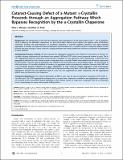| dc.contributor.author | Moreau, Kate Lauren | |
| dc.contributor.author | King, Jonathan Alan | |
| dc.date.accessioned | 2012-07-23T14:47:14Z | |
| dc.date.available | 2012-07-23T14:47:14Z | |
| dc.date.issued | 2012-05 | |
| dc.date.submitted | 2012-04 | |
| dc.identifier.issn | 1932-6203 | |
| dc.identifier.uri | http://hdl.handle.net/1721.1/71748 | |
| dc.description.abstract | Background:
The transparency of the eye lens depends upon maintenance of the native state of the γ- and β-crystallins, which is aided by the abundant chaperones αA- and αB-crystallin. Mature onset cataract, the leading cause of blindness worldwide, involves the polymerization of covalently damaged or partially unfolded crystallins into light-scattering aggregates. A number of single amino acid substitutions and truncations of γ-crystallins result in congenital cataract in both humans and mice, though in many cases the coupling between the protein alterations and the accumulation of aggregates is poorly defined.
Methodology/Principal Findings:
We have studied the aggregation properties and chaperone interactions of human γD-crystallin carrying substitutions of two buried core mutants, I90F and V75D, which cause congenital cataract in mice. The in vitro aggregation pathway competing with productive refolding was not altered by either substitution. Furthermore, this aggregation pathway for both mutant proteins–originating from a partially folded intermediate–was efficiently suppressed by αB-crystallin. Thus the cataract pathology was unlikely to be associated with a direct folding defect. The native state of wild-type human γD-crystallin exhibited no tendency to aggregate under physiological conditions. However both I90F and V75D native-like proteins exhibited slow (days) aggregation to high molecular weight aggregates under physiological conditions. The perturbed conformation of I90F was recognized and bound by both αA and αB chaperones. In contrast, the aggregation derived from the perturbed state of V75D was not suppressed by either chaperone, and the aggregating species were not bound by the chaperone.
Conclusions/Significance:
The cataract phenotype of I90F in mice may be due to premature saturation of the finite α- crystallin pool. The V75D aggregation pathway and its escape from chaperone surveillance and aggregation suppression can account for the congenital cataract pathology of this mutant. Failure of chaperone recognition may be an important source of pathology for many other protein folding defects. | en_US |
| dc.description.sponsorship | National Eye Institute (Grant no. EY015834 ) | en_US |
| dc.description.sponsorship | National Institutes of Health (U.S.) (Grant no. GM17980) | en_US |
| dc.language.iso | en_US | |
| dc.publisher | Public Library of Science | en_US |
| dc.relation.isversionof | http://dx.doi.org/10.1371/journal.pone.0037256 | en_US |
| dc.rights | Creative Commons Attribution | en_US |
| dc.rights.uri | http://creativecommons.org/licenses/by/2.5/ | en_US |
| dc.source | PLoS | en_US |
| dc.title | Cataract-Causing Defect of a Mutant γ-Crystallin Proceeds through an Aggregation Pathway Which Bypasses Recognition by the α-Crystallin Chaperone | en_US |
| dc.type | Article | en_US |
| dc.identifier.citation | Moreau, Kate L., and Jonathan A. King. “Cataract-Causing Defect of a Mutant γ-Crystallin Proceeds Through an Aggregation Pathway Which Bypasses Recognition by the α-Crystallin Chaperone.” Ed. Edathara Abraham. PLoS ONE 7.5 (2012): e37256. | en_US |
| dc.contributor.department | Massachusetts Institute of Technology. Department of Biology | en_US |
| dc.contributor.approver | King, Jonathan Alan | |
| dc.contributor.mitauthor | Moreau, Kate Lauren | |
| dc.contributor.mitauthor | King, Jonathan Alan | |
| dc.relation.journal | PLoS ONE | en_US |
| dc.eprint.version | Final published version | en_US |
| dc.type.uri | http://purl.org/eprint/type/JournalArticle | en_US |
| eprint.status | http://purl.org/eprint/status/PeerReviewed | en_US |
| dspace.orderedauthors | Moreau, Kate L.; King, Jonathan A. | en |
| dc.identifier.orcid | https://orcid.org/0000-0001-6174-217X | |
| mit.license | PUBLISHER_POLICY | en_US |
| mit.metadata.status | Complete | |
